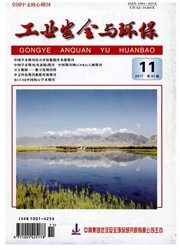

 中文摘要:
中文摘要:
为推进累托石在水处理中的应用,对其进行锂盐改性、造粒及微波活化研究,通过吸附亚甲基蓝比较其处理效果,并对其在水中的填充方式进行了探讨。结果表明,锂累托石吸附性能好,对亚甲基蓝的去除率达97%以上,吸附平衡时间短,仅5 min,是原累托石的1.64倍;为解决固液分离而进行的造粒,堵塞了空隙,降低了吸附性能,采用功率为500 W,辐照时间为10 min的微波对颗粒进行活化后,孔径数量及大小增加,吸附性能提高,锂累托石颗粒散装于容器中需要搅拌,或采用网状框架装置将其束缚固定于水中,便于回收与再生。
 英文摘要:
英文摘要:
To push on the application of rectorite in water treatment, it was modified by lithiumthe, granulated and mi- crowave activated. Its adsorption effect on methylene blue was compared, and the filling way of particles in water was dis- cussed. The results showed that the adsorption performance of lithium rectorite was good, its removal rate of methylene blue reached above 97 %, 1.64 times of the original rectorite, and the adsorption equilibrium time was shortened, just 5mins. The granulation for solving solid - liquid separation made the gaps be blocked and the adsorption performance reduced. When the particles were activated by microwave irradiation with a power of 500 W and irradiation time of 10 rains, the num- ber and size of the gaps increased and the adsorption performance of methylene blue was improved. The lithium - rectorite particles needed to be stirred when they were scattered in a container, or bound to be fixed in the water by using mesh frame device, so that it could be easily recovered and regenerated.
 同期刊论文项目
同期刊论文项目
 同项目期刊论文
同项目期刊论文
 期刊信息
期刊信息
